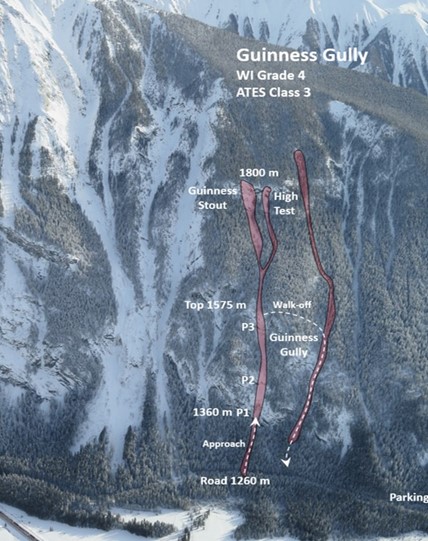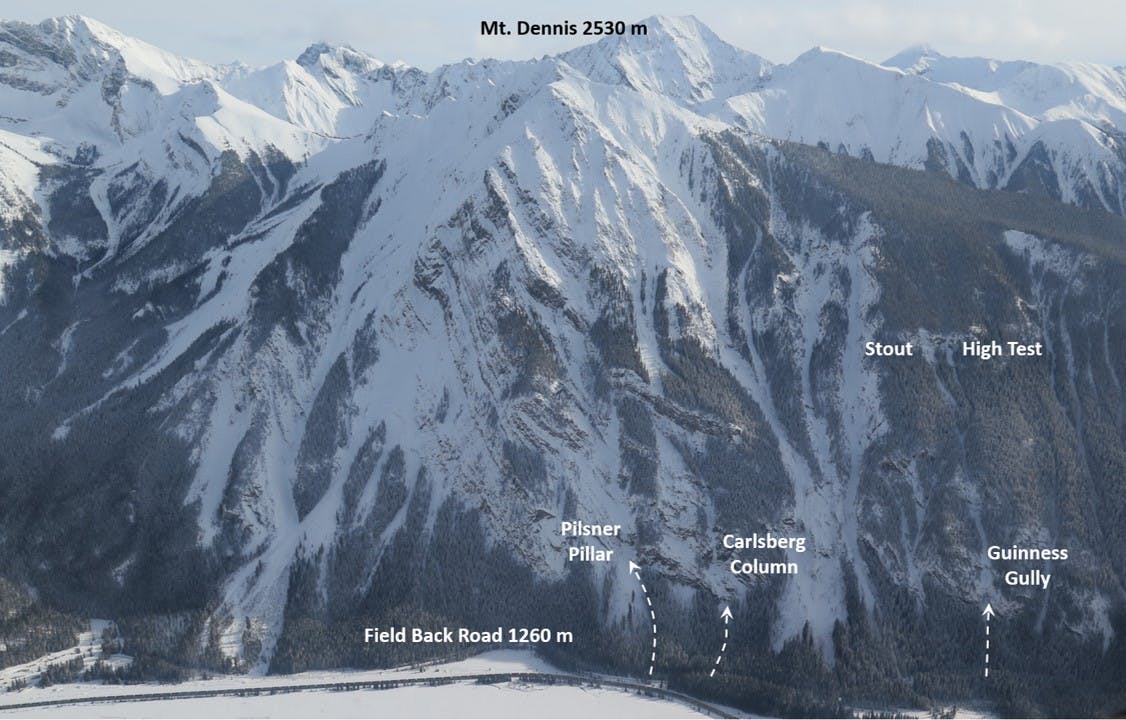
Guinness Gully is the last climb you encounter as you drive from the Field back road. It is also the most popular. A short approach and with nice, tiered pitches mean that many parties can safely enjoy Guinness at the same time. The first pitch is often at the crux, as it can sometimes form quite lean. If you have more time and energy, an extra 45 minute hike up the avalanche path will take you to Stout (above Guinness Gully itself) and Hightest (the drainage to climbers’ right). Both are Grade 4+ and can add another 1-3 pitches in your day, if conditions allow. Guinness Gully is most frequently rapped, but from the top pitch, climbers can traverse through the trees and scramble/walk the gully on climbers’ right. This may involve some down climbing.

Avalanche Control on Mt. Dennis
The Field Back Road beneath Mt. Dennis is an Intermittent Avalanche Closure Zone. Parks Canada does avalanche control to protect the road and the CP Rail line and this means that the road and the climbs will be closed periodically throughout the winter for explosives avalanche control. It is illegal to breach these closures.
Parks Canada posts notifications of closures the day before in the headline of the avalanche forecast. The gates will be closed at both ends of the Field Back Road and signs will indicate the closure. This avalanche control is to protect the road and rail routes, it does not protect the ice climbs. There are many times when natural or human triggered avalanches could run over the climbs, but would not reach the transport routes meaning no avalanche control will be carried out.
Popularity
38 people completed the survey
- 50% climbed it 1-5 times
- 26% climbed it 6-10 times
- 24% climbed it over 10 times
Avalanche Frequency
- 53% have seen debris on the approach to the climb
- 53% have seen debris at the base of the climbs
- 42% have seen debris above the top pitch
- 2% have witnessed avalanches
Time of Year and Day
The most frequent ascents and observations of avalanches were reported from February- April, followed by December to January, and the least frequent was October to November.
- 73% of avalanches witnessed between 6:00am-12:00pm
- 27% of avalanches witnessed between 12:00-18:00pm
- 0% of avalanches witnessed after 6pm
Avalanche Start Zones
- 17% believe it started well above the climb
- 59% believe the avalanche started right above the climb
- 24% were not sure where observed avalanches began
Avalanche Runout Distance Observed
- 71% saw debris at the base of the climb
- 53% saw debris on the approach
- 42% saw debris above the last pitch
- 18% saw debris in the otter slide descent
Notes on Avalanche Debris
- Debris is often witnessed on the road. It has been reported up to 3 m deep.
- Many noted seeing avalanche debris below the first pitch and running most of the way to the road
- People have seen avalanche debris between pitches 1-2 and 2-3
Reported Avalanches and Incidents
- In December 2020, a party was had climbed the 2nd pitch and was gearing up for the 3rd in the trees just below the pitch to the left. A dry loose avalanche came over the top of the pitch and ran over the right side of it
- A small wet avalanche was reported by the notch at the bottom on a spring day after warming and rain. The avalanche was reported around noon
- Sluffs have been reported over the climb large enough to knock someone down
Contributing factors in order of significance
- 38% were believed to be caused by warming and solar radiation
- 50% were believed to be caused by new snow amounts
- 31% were believed to be caused by winds
- 12% were believed to have failed on a known reactive layer
- 19% were believed to be cornice or human/animal triggered
Summary
Guinness Gully is one of the slide paths that is controlled by Parks Canada to keep the road open and this often leaves debris on the climb. Despite this control work, the climb does also avalanche naturally. The side walls also can be of concern for climbers.
The area between Hightest and Stout creates greater hazard for both natural and human triggered avalanches.
There is a neighbouring gully to climbers’ right that can be used to descend, it involves some steep snow downclimbing and can also have avalanche hazard, including human triggering as it is less travelled.
Additional notes from the community
The approach is often easier in crampons. Getting fully ready to climb at the car and repacking at the car at the end of the day can avoid extra time in avalanche terrain.